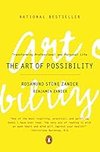
Saved by David Horne and
The Art of Possibility

Saved by David Horne and
And if we make a mistake, we can mentally raise our arms and say, “How fascinating!” and reroute our attention to the higher purpose at hand.
The practice of this chapter, giving way to passion, has two steps: 1. The first step is to notice where you are holding back, and let go. Release those barriers of self that keep you separate and in control, and let the vital energy of passion surge through you, connecting you to all beyond. 2. The second step is to participate wholly. Allow yours
... See morePresence without resistance: you are now free to turn to the question, “What do we want to do from here?” Then all sorts of pathways begin to appear: the possibility of resting; having the best food, sex, reading, or conversation; going to the movies or walking in the rain; or catching the next
Suppose for a moment that vital, expressive energy flows everywhere, that it is the medium for the existence of life, and that any block to participating in that vitality lies within ourselves.
Imagine if we were to faithfully whisper the immortal words of Martin Luther King, Jr., “I have a dream . . . ,” as a preface to our every next remark.
Yet standing stationary on the bank, utterly still, I took an existential leap. “Let its force run through me,” I allowed, not having moved an inch. “Let it turn all my molecules in its direction; trust it and surrender. Let it give me what it has to offer.”
The nature of abstractions is that they have a lasting existence exempt from the contingencies of time and place.
So, the practice of enrollment is about giving yourself as a possibility to others and being ready, in turn, to catch their spark. It is about playing together as partners in a field of light. And the steps to the practice are: 1. Imagine that people are an invitation for enrollment. 2. Stand ready to participate, willing to be moved and inspired.
... See moreWhen our attention is primarily directed to how wrong things are, we lose our power to act effectively. We may have difficulty understanding the total context, discussing what to do next, or overlooking the people who “should not have done what they did” as we think about a solution.